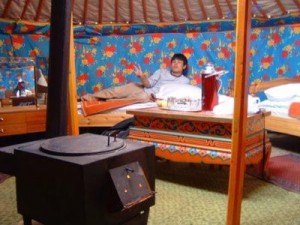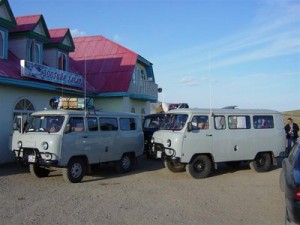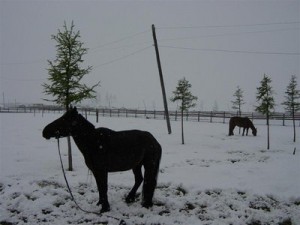Street Kids in Ulanbaatar
My introduction to a Mongolian winter was from 2002-03 as I had just arrived from six months teaching kids in Kunsan, South Korea. In my new job, I was working for a language school called Santis at the time and they were located downtown — just a block from the Mongolian Parliament building. It was cold and the ground was frozen with a covering of dirty snow. The sky was also dirty from the coal smoke. Ulaanbaatar — the whole city — is centrally heated by a Russian built coal-fired plant. Very hot water, or steam, goes into the city through huge underground pipes — they come above ground here and there — but mostly stay under the frozen soil. Apartments in Ulaanbaatar are so hot during the winter that you have to open a ventilating window to let some cold air in. The radiators are NOT adjustable. One of the first things I did was take a walk to the outskirts of town where I could get a view from a nearby hill.
 It was an unwelcoming site at first and my new boss, Orgilma, showed me two apartments to choose between. I thought I had done well, choosing the one closer to work and it had a cinema next door. Little did I know this was the local ‘porn’ theatre nor that the little hotel next door with the picture of Marilyn Monroe out front was the local ‘cat’ house. My encounters with people from these residences is another day’s story — they liked to hang out in the stairwell going up to my apartment.
It was an unwelcoming site at first and my new boss, Orgilma, showed me two apartments to choose between. I thought I had done well, choosing the one closer to work and it had a cinema next door. Little did I know this was the local ‘porn’ theatre nor that the little hotel next door with the picture of Marilyn Monroe out front was the local ‘cat’ house. My encounters with people from these residences is another day’s story — they liked to hang out in the stairwell going up to my apartment.
Ulaanbaatar is a strange place and a lot of people living there still don’t have apartments or houses. A lot of children there are homeless and survive the winter by going underground — living beside those steam pipes coming from the heating plant. They still have to eat and I remember how they would creep into the restaurants around town, scrounging for leftovers on the diners’ tables. It was a pitiful sight that wrenched at my heart. Many of the kids living around Ulaanbaatar with their families were in ‘gers’.
 These are round, tent-like houses — made of sheep wool felt, covered with plastic or a tarp — and supported on a moveable wooden frame. I got to sleep in one and they were quite warm as long as you continued to feed the pot-bellied stove in the middle. This meant getting up in the middle of the night a few times and shoveling in dried horse or cow manure. The stuff burns cleanly and is warm. For a lot of children living in gers, this becomes a life and death family chore. I imagine it is hard to go all winter long without so many hot showers. I have seen kids at the river with an axe, chopping holes in the ice to get at the water below. It would take a while to heat in a ger but eventually one could take a bucket bath in a warm corner. A lot of the kids I saw were obviously survivors — tough as nails. I just had a hard time going to the ‘outhouse’ when I was living in a ger. I nearly dropped frozen ‘turds’ most of the time, or so I thought. Actually, I shouldn’t exaggerate. Many gers are as comfortable as the apartment I stayed in.
These are round, tent-like houses — made of sheep wool felt, covered with plastic or a tarp — and supported on a moveable wooden frame. I got to sleep in one and they were quite warm as long as you continued to feed the pot-bellied stove in the middle. This meant getting up in the middle of the night a few times and shoveling in dried horse or cow manure. The stuff burns cleanly and is warm. For a lot of children living in gers, this becomes a life and death family chore. I imagine it is hard to go all winter long without so many hot showers. I have seen kids at the river with an axe, chopping holes in the ice to get at the water below. It would take a while to heat in a ger but eventually one could take a bucket bath in a warm corner. A lot of the kids I saw were obviously survivors — tough as nails. I just had a hard time going to the ‘outhouse’ when I was living in a ger. I nearly dropped frozen ‘turds’ most of the time, or so I thought. Actually, I shouldn’t exaggerate. Many gers are as comfortable as the apartment I stayed in.
I made the mistake of welcoming some street kids into my apartment. At first, they would just show up at the door — asking for a bottle of water. I used to watch the boys from my window — looking down at them pulling useful waste from the dumpster outside the apartment. Eventually, I asked a couple of them in and fed them a meal. One thing led to another and I had them take a bath and threw their dirty rags into the washing machine. They had become ‘part-time residents’ in my home — at least, when I was there to supervise them.
The next week saw me introduce them to my class of students while we were playing cards and having a party in my apartment. My students warned me about the temptation for them to steal from me and run away. This happened the following week — I unfortunately had to send them back out into the cold. As compensation of a sort, I moved into a home-stay with one of my students and her family. My student’s nephew also lived in a ger and we became close. I was still in contact with street kids but just couldn’t invite them any closer into my life. I hope to return to Ulaanbaatar some day and give it another chance. Now that I have some experience of hosting Burmese homeless children in Thailand I might be able to cope better the next time.
 I met a lot of interesting people in Mongolia and some of them were fellow teachers working at Santis. I remember one Mexican American who had already been there for a whole year as a Peace Corps volunteer. He lived alone near his host family in a ger of his own in the middle of nowhere. He told me plenty of stories about Mongolian hospitality — where it is so cold most of the time, there is no such thing as ‘turning away’ unwelcome guests. I had tried this hospitality with street kids but gotten ‘burned’ in the process. I think it is hard for street kids to ‘turn off’ their survival instincts and become used to living in a secure home. I remember the process was slow in the beginning with Burmese children in Thailand. The children I have helped there realize themselves as part of an extended family now — the congregation of their church. They have a safety net that many children in Mongolia may not have. Anyway, this experienced Peace Corps volunteer helped arrange and lead our Russian ‘van’ exploration of the frosty countryside in the dead of winter. Many of these vans are 30 years old and some are older but most have been refurbished and have replacement motors. They also have 4-wheel drive.
I met a lot of interesting people in Mongolia and some of them were fellow teachers working at Santis. I remember one Mexican American who had already been there for a whole year as a Peace Corps volunteer. He lived alone near his host family in a ger of his own in the middle of nowhere. He told me plenty of stories about Mongolian hospitality — where it is so cold most of the time, there is no such thing as ‘turning away’ unwelcome guests. I had tried this hospitality with street kids but gotten ‘burned’ in the process. I think it is hard for street kids to ‘turn off’ their survival instincts and become used to living in a secure home. I remember the process was slow in the beginning with Burmese children in Thailand. The children I have helped there realize themselves as part of an extended family now — the congregation of their church. They have a safety net that many children in Mongolia may not have. Anyway, this experienced Peace Corps volunteer helped arrange and lead our Russian ‘van’ exploration of the frosty countryside in the dead of winter. Many of these vans are 30 years old and some are older but most have been refurbished and have replacement motors. They also have 4-wheel drive.
They might not look like much but a driver using one was able to come first in a cross-Russia rally. Appearances are deceiving. We traveled to the Gobi Desert in the snow — slid down frozen sand dunes and camped out in gers for the duration of our trip. Where there weren’t roads, the van made its own. It was also the first time I’ve seen camels in a desert in the middle of winter. I don’t have any of my original pictures of Mongolia so I’m making these stand in their place. Yaks are familiar enough from my treks to Langtung Valley in Nepal near the Tibetan border. I have had plenty of yak cheese on pizzas high in the Himalaya. I haven’t eaten roasted camel yet but wouldn’t mind giving it a try some day.
 Another place we visited by van was to stay in a ger in a National Forest near Ulaanbaatar. This was to introduce us to the lifestyle of a nomadic herdsman. This picture IS pretty accurate. I don’t know why we rode the horses to Dinosaur Rocks — except to freeze our ‘dongs’ pissing into the wind. I have never ridden horses before — maybe twice in my life. I mostly just let the horse do his thing while I held on. We did eat horse meat, though — horse meat stew, to be exact. Everyone complimented me on my cooking at the time. I thought it was a bit ‘chewy’ but it did give us a lot of energy. I’m not yet ready for ‘dog meat soup’ nor the ‘fried cat’ I was offered by my Burmese cook in Thailand. I am still working on those flavors of Asia.
Another place we visited by van was to stay in a ger in a National Forest near Ulaanbaatar. This was to introduce us to the lifestyle of a nomadic herdsman. This picture IS pretty accurate. I don’t know why we rode the horses to Dinosaur Rocks — except to freeze our ‘dongs’ pissing into the wind. I have never ridden horses before — maybe twice in my life. I mostly just let the horse do his thing while I held on. We did eat horse meat, though — horse meat stew, to be exact. Everyone complimented me on my cooking at the time. I thought it was a bit ‘chewy’ but it did give us a lot of energy. I’m not yet ready for ‘dog meat soup’ nor the ‘fried cat’ I was offered by my Burmese cook in Thailand. I am still working on those flavors of Asia.
Our trucking trip took us to another small town in Ulaanbaatar. I don’t remember the name except that it was the site of a famous Buddhist monastery — one of the few that survived Chinese and Russian intervention in the governance of Mongolia. We visited there and were given a tour on a cold and windy day. All that remains of the original monastery are a few dusty old buildings and the compound wall stretching around it. We stayed in another ger that night beside German tourists and drank a lot of Mongolian vodka. I DON’T remember the next morning and won’t write about it.
Of course, the sky is not always so dark and foreboding in Mongolia. The country is famous for its blue skies and colors. You just have to be there during the summer when it is available to experience. This is something I hope to do next year in 2010. Seven long years away from Mongolia has reminded me of what I might have missed when I decided to leave for warmer climates.
I had thought of going into partnership with a Mongolian woman and my student friend to open a kindergarten. Ultimately, I went to China to get experience teaching young children. Now that I have that under my belt, it may be time to return to that idea for the future. I hope to become a kindergarten teacher again with younger children somewhere in South Asia where it is a bit warmer. If the world is getting ready for a new ice age I don’t think Mongolia will remain a hospitable place.
Filed under: Mongolia and
Leave a Reply